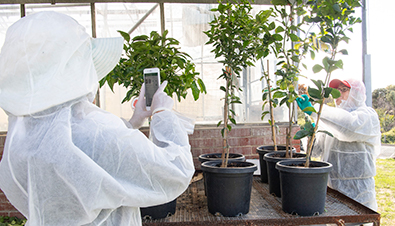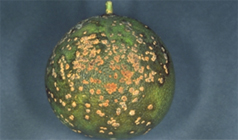Read the latest information on
Foot-and-mouth disease

Surveillance for citrus canker during the response. Image courtesy of WA DPIRD
After a three-year effort, citrus canker (caused by Xanthomonas citri subsp. citri) has been eradicated from Australia.
Citrus canker was detected in a plant wholesaler in the Northern Territory (NT) in April 2018 and subsequently found on three properties in northern Western Australia (WA) in April 2018. Prior to this outbreak, Australia had been free of citrus canker since 2009.
The tropical disease, affecting citrus such as oranges, limes, lemons and mandarins, has been eradicated thanks to the support of the local community and industry.
Nationally, the citrus industry is valued at $942 million, with exports valued at around $508 million, while the nursery sector, which supplies nursery stock into citrus industry and retail supply chains, is valued at $2.6 billion.
The disease had the potential to impact the national citrus industry through loss of trees, reduced fruit production, reputation risk lowering prices for fruit into market, with the potential for loss of important international markets if left unchecked.
Through a national cost-shared program that ran from May 2018 to March 2021, eradication was critical to protect Australia’s national citrus industry and international markets.

Xanthomonas citri subsp. citri. Photo by Florida Division of Plant Industry Archive, Florida Department of Agriculture and Consumer Services, Bugwood.org
Funding for the National Citrus Canker Eradication Program was provided by the Australian Government, state and territory governments, and citrus and nursery industry partners. The program action plan outlined:
The community should be acknowledged for their role in supporting the eradication efforts.
Being free from citrus canker means that growers from all over Australia will continue to be able to access international markets. Locally, growers will be able to move plants and plant-related products interstate without the need for additional treatments or inspections. This is important for ensuring our growers remain competitive and profitable.
Proof of freedom was agreed by the National Management Group on 8 April 2021. Work will now begin on adjusting the biosecurity arrangements back to ‘pre-citrus-canker’ times.
Citrus canker fact sheet (Plant Health Australia)
Acknowledgement: Based on a media release by the NT Department of Primary Industry and Resources